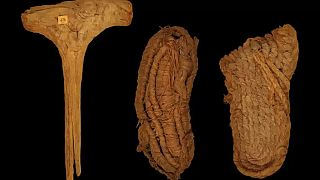
The grass-woven sandals were first retrieved along with various tools and artefacts by 19th-century miners
MADRID, Sept 30 (NNN-AGENCIES) –Scientists in Spain have confirmed that sandals recovered from a cave more than 150 years ago are in fact the oldest footwear ever discovered in Europe.
The objects were originally unearthed in the 1850s from Cueva de los Murciélagos, an ancient cave a few miles inland from the Granada coast that was mined first for bat guano and minerals.
As the miners moved deeper underground, they uncovered a gallery containing mummified corpses and numerous wooden and woven artefacts – a burial site dating back millennia.
While the miners initially removed and destroyed many items from the site, archaeologists were able to recover some that remained. Testimony gathered from villagers shortly after the discovery indicated that 68 sets of ancient human remains had been found and distributed in the area, but most have never been recovered.
According to the authors of the study, published in the journal Science Advances, the artefacts’ exceptional contribution to the understanding of Neolithic European life and technology is still becoming clear nearly two centuries after their discovery.
“Despite the mining activity, this assemblage represents one of the oldest and best-preserved collections of hunter-gatherer basketry in southern Europe,” the study’s authors write. “The sandals, baskets, and wooden artefacts with Neolithic chronologies constitute a unique sample of organic artefacts absent in other archaeological sites of early farmer communities.”
Of particular interest in the collection are a number of sandals, two of which the scientists say date from more than 6,000 years ago. However, the oldest objects in the collection may be as many as nine millennia old.
The fact the objects have been so unusually well preserved, the study’s authors explain, can be chalked up to the cave’s “null humidity” and the climate surrounding it.
“A dry wind current is generated by the prevailing climate in the area, and the north-south direction and narrow and deep morphology of the Angosturas gorge channel the wind toward the cave, through the narrow upper entrance. The wind cools as it travels through the cave, increasing in speed; it is cold as it exits through another narrow entrance located in the lower part of the shelter.
“The lack of prevailing humidity in the area and the circulation of wind in the cave as it cools and dries prevent the proliferation of bacteria, increasing the amount and diversity of preserved perishable material at the site.” — NNN-AGENCIES




